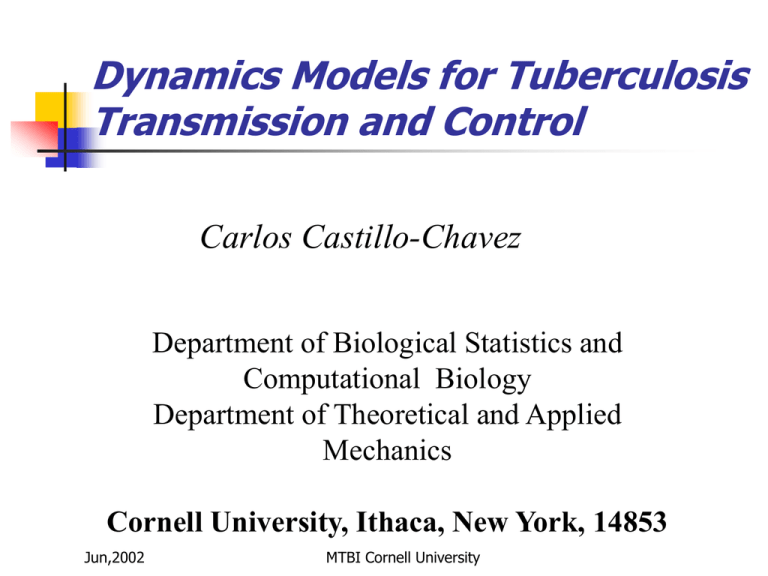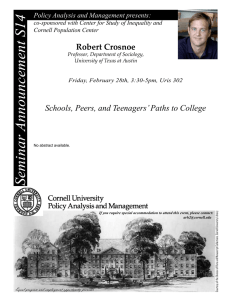RutgersTB1.ppt
advertisement

Dynamics Models for Tuberculosis Transmission and Control Carlos Castillo-Chavez Department of Biological Statistics and Computational Biology Department of Theoretical and Applied Mechanics Cornell University, Ithaca, New York, 14853 Jun,2002 MTBI Cornell University Ancient disease • TB has a history as long as the human race. • TB appears in the history of nearly every culture. • TB was probably transferred from animals to humans. • TB thrives in dense populations. • It was the most important cause of death up to the middle of the 19th century. Jun,2002 MTBI Cornell University Transmission Process • Causative agent: Tuberculosis Bacilli (Koch, 1882). • Preferred habitat Lung. • Main Mode of transmission Host-air-host. • Immune Response Immune system tends to respond quickly to initial invasion. Jun,2002 MTBI Cornell University Immune System Response Caricature • Bacteria invades lung tissue. • White cells surround the invaders and try to destroy them. • Body builds a wall of cells and fibers around the bacteria to confine them, forming a small hard lump. Jun,2002 MTBI Cornell University Immune System Response Caricature • Bacteria cannot cause additional damage as long as confining walls remain unbroken. • Most infected individuals never develop active TB (that is, become infectious). • Most remain latently-infected for life. • Infection progresses and develops into active TB in less than 10% of the cases. Jun,2002 MTBI Cornell University TB was the main cause of mortality • Leading cause of death in the past. • Accounted for one third of all deaths in the 19th century. • One billion people died of TB during the 19th and early 20th centuries. • TB’s nicknames: White Death, Captain of Death, Time bomb Jun,2002 MTBI Cornell University Per Capita Death Rate of TB Jun,2002 MTBI Cornell University Current Situation • Two to three million people around the world die of TB each year. • Someone is infected with TB every second. • One third of the world population is infected with TB ( the prevalence in the US is 10-15% ). • Twenty three countries in South East Asia and Sub Saharan Africa account for 80% total cases around the world. • 70% untreated actively infected individuals die. Jun,2002 MTBI Cornell University TB in the US Jun,2002 MTBI Cornell University Reasons for TB Persistence • Co-infection with HIV/AIDS (10% who are HIV positive are also TB infected). • Multi-drug resistance is mostly due to incomplete treatment. • Immigration accounts for 40% or more of all new recent cases. • Lack of public knowledge about modes of TB transmission and prevention. Jun,2002 MTBI Cornell University Earliest Models • • • • Jun,2002 H.T. Waaler, 1962 C.S. ReVelle, 1967 S. Brogger, 1967 S.H. Ferebee, 1967 MTBI Cornell University Epidemiological Classes Jun,2002 MTBI Cornell University Parameters Jun,2002 MTBI Cornell University Basic Model Framework B' ( N , T , I ) F (N ) S B( N , S , I ) S • • • • E E N=S+E+I+T, Total population F(N): Birth and immigration rate B(N,S,I): Transmission rate (incidence) B`(N,S,I): Transmission rate (incidence) Jun,2002 MTBI Cornell University kE I r1 I ( d) I r 2E T T Model Equations dS F (N ) CS I I , N dt dE CS I ( k r2)E 'CT I , N N dt dI kE ( d r1)E, dt dT r2 E r1I ' CT I T , N dt N S E I T Jun,2002 MTBI Cornell University Epidemiology (Basic Reproductive Number, R0) The expected number of secondary infections produced by a “typical” infectious individual during his/her entire infectious period when introduced in a population of mostly susceptibles at a demographic steady state. • • Sir Ronald Ross (1911) Kermack and McKendrick (1927) Jun,2002 MTBI Cornell University Epidemiology (Basic Reproductive Number, R0) Frost (1937) wrote “…it is not necessary that transmission be immediately and completely prevented. It is necessary only that the rate of transmission be held permanently below the level at which a given number of infection spreading (i.e. open) cases succeed in establishing an equivalent number to carry on the succession” Jun,2002 MTBI Cornell University R0 R0 C k r1 d r2 k k r2 k • Probability of surviving the latent stage: • Average effective contact rate C • Average effective infectious period 1 r1 d Jun,2002 MTBI Cornell University Demography dN F ( N ) N dI , dt dE C ( N E I ) I ( k r )E, 2 N dt dI kE ( d r )I . 1 dt F(N)=, Linear Growth F (N ) rN , Exponentia l Growth N F (N ) rN 1 , Logistic Growth K Jun,2002 MTBI Cornell University Exponential Growth (Three Thresholds) The Basic Reproductive Number is R0 Jun,2002 C k r1 d r2 k MTBI Cornell University Demography and Epidemiology R1 Jun,2002 C k r r1 d r r2 k MTBI Cornell University Demography r R2 * du Where 2 4d (C d )(kC mr nr )c (d (mr nr ) C )(mr k ) d ( m n c ( m k ) r r r u* 2d (C d )(kC mr nr ) Jun,2002 MTBI Cornell University Bifurcation Diagram (exponential growth ) r R1 N 0 I N u * N 0 ( R2 1) I ( R2 1) 1 I N I 0 I N I 0 0 R0 1 Jun,2002 MTBI Cornell University Logistic Growth βC k R0 μ r1 d μ r2 k R* 2 Jun,2002 r R0 1 k μ d μ d k r1 R0 MTBI Cornell University Logistic Growth (cont’d) If R2* >1 • When R0 1, the disease dies out at an exponential • • rate. The decay rate is of the order of R0 – 1. Model is equivalent to a monotone system. A general version of the Poincaré-Bendixson Theorem is used to show that the endemic state (positive equilibrium) is globally stable whenever R0 >1. When R0 1, there is no qualitative difference between logistic and exponential growth. Jun,2002 MTBI Cornell University Bifurcation Diagram I* Global Transcriti cal Bifurcatio n 1 Jun,2002 MTBI Cornell University R0 Particular Dynamics (R0 >1 and R2* <1) All trajectories approach the origin. Global attraction is verified numerically by randomly choosing 5000 sets of initial conditions. Jun,2002 MTBI Cornell University Fast and Slow TB (S. Blower, et al., 1995) pSI S (1 p)SI S Jun,2002 E kE E MTBI Cornell University I ( d)I Fast and Slow TB dS SI S, dt dE (1 p) SI kE E, dt dI p SI kE dI I. dt Jun,2002 MTBI Cornell University Variable Latency Period (Z. Feng, et al,2001) p(s): proportion of infected (noninfectious) individuals who became infective s unit of time ago and who are still infected (non infectious). Number of exposed from 0 to t who are alive and still in the E class Number of those who progress to infectious from 0 to t and who are still alive in I class at time t Jun,2002 MTBI Cornell University Variable Latency Period (differentio-integral model) • • E0(t): # of individuals in E class at t=0 and still in E class at time t I0: # of individuals in I class at t=0 and still in I class at time t Jun,2002 MTBI Cornell University Exogenous Reinfection p cS I N cS I S N S kE E E I rI ( d) I cT I N Jun,2002 MTBI Cornell University T T Exogenous Reinfection dS c S I S , dt N dE c S I pc E I (k )E c T I , dt N N N dI pc E I kE (d r )I , dt N dT rI-cT I T , dt N N S E I T. Jun,2002 MTBI Cornell University Backward Bifurcation Jun,2002 MTBI Cornell University Age Structure Model dt dt dt dt dt s(t , a) (a)c(a) B(t ) s(t , a) ( (a) (a))s(t , a), da v(t , a) (a)s(t , a) (a)v(t , a) (a) B(t )v(t , a), da l (t , a) (a)c(a) B(t ) s(t , a) σj(t,a) δv(t,a) (k μ(a))l(t,a), da i(t , a) kl (t , a) (r (a))i(t , a), da j (t , a) ri(t , a) (a)c(a) B(t ) j (t , a) - (a) j (t , a). da Jun,2002 MTBI Cornell University Parameters • • • • • • • • : recruitment rate. (a): age-specific probability of becoming infected. c(a): age-specific per-capita contact rate. (a); age-specific per-capita mortality rate. k: progression rate from infected to infectious. r: treatment rate. : reduction proportion due to prior exposure to TB. : reduction proportion due to vaccination. Jun,2002 MTBI Cornell University Proportionate Mixing • p(t,a,a`): probability that an individual of age a has contact with an individual of age a` given that it has a contact with a member of the population . • Proportionate mixing: p(t,a,a`)= p(t,a`) Jun,2002 MTBI Cornell University Incidence and Mixing B(t ) i(t, a') p(t, a, a')da' n(t, a') 0 p(t, a') c(a')n(t, a') , c(u)n(t,u)du random mixing 0 Initial values : s(t,0) , v(t,0) l (t,0) i(t,0) j(t,0) 0. Boundary values: s(0, a) s0 (a), v(0, a) v0 (a), l (0, a) l0 (a), i(0, a) i0 (a), j(0, a) j0 (a). n(t, a) s(t, a) v(t, a) l (t, a) i(t, a) j(t, a) Jun,2002 MTBI Cornell University Basic reproductive Number (by next generation operator) R0 ( ) k p ( ) ( )c( ) e ( k ) e ( r) ( )dd rk 00 (a) F (a) (1 F (a)) a F (a) exp( (b)db) denotes the probabilit y that a 0 susceptibl e individual has not been vacci nated at age a. Jun,2002 MTBI Cornell University Stability There exists an endemic steady state whenever R0()>1. The infection-free steady state is globally asymptotically stable when R0= R0(0)<1. Jun,2002 MTBI Cornell University Optimal Vaccination Strategies Two optimization problems: If the goal is to bring R0() to pre-assigned value then find the vaccination strategy (a) that minimizes the total cost associated with this goal (reduced prevalence to a target level). If the budget is fixed (cost) find a vaccination strategy (a) that minimizes R0(), that is, that minimizes the prevalence. Jun,2002 MTBI Cornell University Optimal Strategies • One–age strategy: vaccinate the susceptible population at exactly age A. • Two–age strategy: vaccinate part of the susceptible population at exactly age A1 and the remaining susceptibles at a later age A2. Optimal strategy depends on data. Jun,2002 MTBI Cornell University Challenging Questions associated with TB Transmission and Control • • • • • • Impact of immigration. Antibiotic Resistance. Role of public transportation. Globalization—small world dynamics. Time-dependent models. Estimation of parameters and distributions. Jun,2002 MTBI Cornell University
